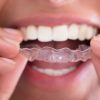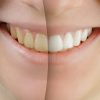Chewing gum is as popular as ever, even though many consumers think of chewing gum as a kind of candy, and that it is bad for your health. However, the physical act of chewing increases salivary flow in the mouth and if chewed after eating, the increased salivary flow can help neutralize and wash away the acids that are produced when food is broken down by the bacteria in plaque on teeth. Over time, acid can break down tooth enamel, creating the conditions for decay. Increased saliva flow also carries with it more calcium and phosphate to help strengthen tooth enamel. Clinical studies have shown that chewing sugarless gum for 20 minutes following meals can help prevent tooth decay.
In the future, look for chewing gum that delivers a variety of therapeutic agents that could provide additional benefits to those provided by the ability of gum to stimulate saliva flow. For instance, some gum might contain active agents that could enhance the gum’s ability to re-mineralize teeth and reduce decay, or enable gum to help reduce plaque and gingivitis.
The ADA Seal recognizes chewing gum under the category of the ADA Seal which has demonstrated scientifically that it can protect the teeth. A company earns the ADA Seal of Acceptance by producing scientific evidence that demonstrates the safety and efficacy of its product, which the ADA Council on Scientific Affairs carefully evaluates according to objective requirements.
Did You Know that chewing gum in various forms has been around since ancient times when it was derived from tree saps?
In ancient times, the Greeks chewed sap from the mastic tree. On the other side of the world, the ancient Mayans favored the sap of the sapodilla tree. Native Americans from New England chewed spruce sap—a habit they passed on to European settlers. Today, the base used for most gum products is a blend of synthetic materials (elastomers, resins and waxes in various proportions).
Does chewing gum replace brushing and flossing?
No, chewing gum is something we do in addition to brushing and flossing, not as a substitute. The ADA recommends brushing twice a day with a fluoride toothpaste and cleaning plaque from between your teeth once a day with dental floss or other interproximal dental cleaners.
ADA Seal of Acceptance: Chewing Gum
The ADA Seal is your assurance that the gum product has been objectively evaluated for safety and efficacy by an independent body of scientific experts, the ADA Council on Scientific Affairs.
A company earns the ADA Seal by demonstrating that its product meets the requirements for safety and efficacy for sugar-free chewing gum. Efficacy may include one or more specific indications, such as reducing plaque acids, promoting re-mineralization of tooth enamel, reducing cavities and/or reducing gingivitis. Studies must also show that the gum is safe to oral tissues and the manufacturer must provide the results of both laboratory studies and clinical studies in humans.
Does the ADA award its Seal to sugar-containing gum?
To date, the only chewing gums with the ADA Seal are sugarless. They are sweetened by non-cavity-causing sweeteners such as aspartame, sorbitol or mannitol. Chewing sugarless gum has been shown to increase the flow of saliva, thereby reducing plaque acid, strengthening the teeth and reducing tooth decay.
About Johnson Family Dentistry – Orlando, FL
At Johnson Family Dentistry, we are a dental practice devoted to restoring and enhancing the natural beauty of your smile using conservative, state-of-the-art procedures that will result in beautiful, long, lasting smiles. We are conveniently located next to Publix Super Market in The Shoppes at Eastwood. Contact us Today at (407) 282-0002.
Our Services include the following; Bonding, Crowns & Bridgework, Dental Implants, Fillings, General and Cosmetic Dentistry, Oral Cancer Screenings, Periodontal (Gum) Disease Therapy, Porcelain Veneers, Professional Teeth Cleanings, Removable Dentures, Root Canal Treatment, Sealants, Teeth Whitening, TMJ/TMD Treatment, and Tooth Extractions.





